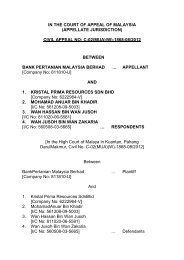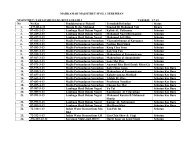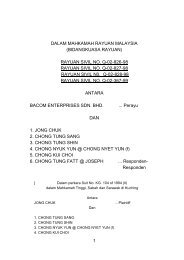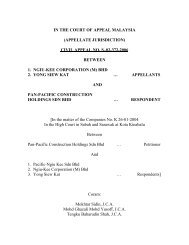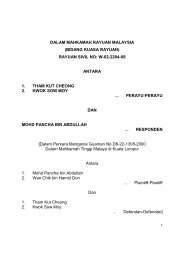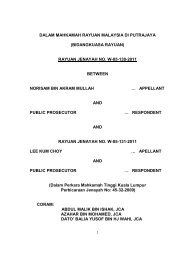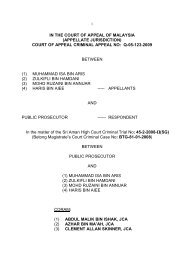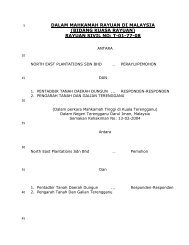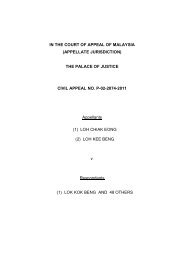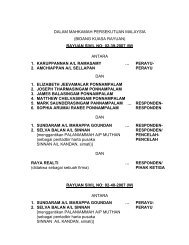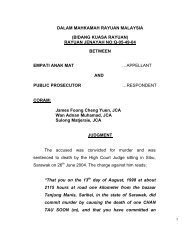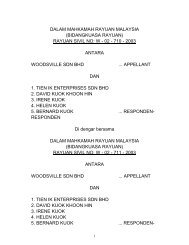DALAM MAHKAMAH RAYUAN MALAYSIA (BIDANG KUASA ...
DALAM MAHKAMAH RAYUAN MALAYSIA (BIDANG KUASA ...
DALAM MAHKAMAH RAYUAN MALAYSIA (BIDANG KUASA ...
You also want an ePaper? Increase the reach of your titles
YUMPU automatically turns print PDFs into web optimized ePapers that Google loves.
<strong>DALAM</strong> <strong>MAHKAMAH</strong> <strong>RAYUAN</strong> <strong>MALAYSIA</strong><br />
(<strong>BIDANG</strong> <strong>KUASA</strong> <strong>RAYUAN</strong>)<br />
<strong>RAYUAN</strong> JENAYAH NO: J-05-118-2009<br />
DI ANTARA<br />
(1) SAMUGEN PAKRI<br />
(NO. K/P: 770925-01-6521)<br />
(2) PRAKASH A/L SIVASANG KARAN<br />
(NO. K/P: 730517-14-5363)<br />
(3) KUMARAN VISMANATHAN<br />
(NO K/P: 730904-02-5767) … PERAYU-<br />
PERAYU<br />
DAN<br />
PENDAKWA RAYA … RESPONDEN<br />
[Dalam Kes Jenayah Di Mahkamah Tinggi Malaya<br />
di Johor Bahru<br />
Di Antara<br />
Pendakwa Raya<br />
Dan<br />
(1) Samugen Pakri<br />
(2) Prakash a/l Sivasang Karan<br />
(3) Kumaran Vismanathan<br />
Page 1 of 31
CORAM: HASAN LAH, JCA<br />
SULONG MATJERAIE, JCA<br />
SULAIMAN DAUD, JCA<br />
Introduction<br />
GROUNDS OF JUDGMENT<br />
[1] The 3 appellants were jointly charged with the offence of<br />
trafficking 45,496.6 grams of cannabis, under s. 39B(1)(a) of<br />
the Dangerous Drugs Act 1952 (“the Act”) in furtherance of<br />
their common intention pursuant to s. 34 of the Penal Code<br />
or alternatively they were charged for doing an act<br />
preparatory to traffic the same, an offence under s 39B(1)(c)<br />
of the Act.<br />
[2] At the close of the case for the prosecution, the learned trial<br />
judge ordered the 3 appellants to enter their defence on the<br />
principal charge and also on the alternative charge. At the<br />
close of their defence case they were convicted of the<br />
principal charge and sentenced to death. Hence, they<br />
appealed to us against the decision of the learned trial judge.<br />
Page 2 of 31
[3] We heard and dismissed their appeal. We now give our<br />
grounds.<br />
Case For the Prosecution<br />
[4] At the close of the case for the prosecution, the narrative of<br />
the learned trial judge’s finding of facts may be unfolded as<br />
follows.<br />
[5] On 29.10.2002, Assistant Superintendant of Police Charun<br />
a/l Aai Been (PW2) acting on information received from an<br />
informer instructed Det/Corporal Goh Kwang Bang (PW4) to<br />
become an undercover agent playing the role as the<br />
interested buyer who was willing to buy the cannabis from an<br />
Indian man by the name of ‘Boy’. PW4 was given a bag<br />
containing RM45,000.00 being the purchase price of the<br />
cannabis.<br />
[6] PW2 then instructed Chief Inspector Zamri bin Razab (PW5)<br />
to head a police raiding team with the assignment to make<br />
an arrest on the suspects who would sell the cannabis to<br />
PW4. PW5 was instructed to wait for the pre-arranged<br />
signal from PW4 indicating that the cannabis was already in<br />
sight.<br />
[7] On 1.11.2002 at about 10.00 p.m., PW4 proceeded to the<br />
agreed place to meet the ‘seller’ at Restoran Ayu, Taman<br />
Page 3 of 31
Ungku Tun Aminah, Skudai, Johor Bahru. After that PW4<br />
saw PW5 together with his team arriving at the scene. A<br />
little while later, the informer arrived at the scene together<br />
with two Indian men. The informer introduced to PW4 one of<br />
the men, subsequently identified as the first appellant as<br />
“Boy”. The informer then left the scene stating that he had<br />
something else to do.<br />
[8] The first appellant then introduced the other Indian men,<br />
subsequently identified as the second appellant, to PW4.<br />
Afterwards the three of them started to discuss about the<br />
drugs which were going to be sold. The second appellant<br />
asked PW4 whether he had the money with him and he<br />
wanted to increase the price of the cannabis from RM900.00<br />
per kilogram to RM1000.00. PW4 did not agree with the<br />
new price.<br />
[9] The two appellants then talked in Tamil language between<br />
them and subsequently the second appellant told PW4 that<br />
the original price of RM900.00 per kilogram was maintained.<br />
PW4 agreed to the offer.<br />
[10] The second appellant then requested to look at the purchase<br />
money and indicated that he would like to count them. PW4<br />
took the second appellant to a room at the rear portion of the<br />
Page 4 of 31
estaurant and inside the room PW4 showed the money to<br />
the second appellant. After the money was handed over to<br />
the second appellant, the second appellant then proceeded<br />
to count them. Halfway through, the second appellant<br />
stopped counting the money indicating that he trusted PW4.<br />
PW4 then requested the money to be returned to him and he<br />
told the second appellant that he wanted to look at the<br />
cannabis first.<br />
[11] The second appellant then made a phone call from his cell<br />
phone and spoke in Tamil. Not long after that, a Proton Wira<br />
car came and stopped at about 10 to 15 meters from where<br />
they were sitting. The car was parked with its front facing<br />
the restaurant. At that moment, the second appellant told<br />
PW4 “barang telah sampai”. He then invited PW4 to go to<br />
the car to inspect the cannabis.<br />
[12] PW4 testified that he saw a man, subsequently identified as<br />
the third appellant, alighted from the car and proceeded to<br />
the boot. The third appellant then opened the boot of the<br />
car. At that moment PW4 saw 3 boxes inside the boot. He<br />
then requested the second appellant to open one of the<br />
boxes to show him the cannabis. The second appellant then<br />
opened one of the boxes and took out a compressed slab<br />
and showed it to PW4.<br />
Page 5 of 31
[13] After confirming that the drugs were already in sight PW4<br />
proceeded to give the pre-arranged signal to the police<br />
team. It was at that point PW5 and his men approached the<br />
Proton Wira car. PW5 then introduced himself as a police<br />
officer and at once, all the three appellants ran away from<br />
the spot. However, PW4 with the help of PW5 and another<br />
police officer managed to arrest the second appellant after<br />
he put up a struggle. According to PW5, two of his men<br />
managed to arrest the third appellant about 50 meters away<br />
from the car. Another two members of the raiding team<br />
managed to arrest the first appellant about 40 meters from<br />
the car. The third appellant and the first appellant had also<br />
put up a struggle before being arrested by the police.<br />
(14) Later on, upon inspection into the boot of the car PW5 found<br />
3 boxes. One of them had been opened. From one of the<br />
boxes, PW5 recovered 25 compressed slabs of plant<br />
material suspected to be cannabis. The other two boxes<br />
contained 12 and 13 similar slabs respectively.<br />
[15] All the 3 appellants together with the Proton Wira car and the<br />
drug exhibits were after that taken back to the Police Station<br />
and afterward handed over by PW5 to PW6, the<br />
Investigating Officer of the case. The drugs, as analysed by<br />
Page 6 of 31
the government chemist (PW3) contained 45,496.6 grams of<br />
cannabis.<br />
Defence case<br />
[16] All the 3 appellants elected to give evidence on oath. Their<br />
defence had been summarised by the learned trial judge in<br />
his judgment and they are as follows. The first appellant<br />
stated that on 1.11.2002 he was directed by a friend of his<br />
known as “Sia Fei” whom he had known for about 3 years<br />
prior to that day to get three boxes of cigarettes from<br />
someone named “Siva” in Kulai. The first appellant then<br />
together with the second appellant in the latter’s car went to<br />
Toll Kulai as directed. They arrived there at about 5.30 p.m.<br />
and met the man named Siva, who was waiting for them with<br />
the 3 boxes of cigarettes.<br />
[17] After putting the 3 boxes of cigarettes in the boot of the<br />
second appellant’s car the first appellant and the second<br />
appellant went to Taman Daya to meet the third appellant<br />
who was their long time friend. The three of them had earlier<br />
planned to go back to Kedah to celebrate Deepavali. They<br />
fetched the third appellant at his house at about 7.00 p.m.<br />
From there they went to another friend’s house by the name<br />
Page 7 of 31
of Vasu. At Vasu’s house they stopped there and had some<br />
drinks.<br />
[18] While at Vasu’s house, the first appellant received a call<br />
from Sia Fei. Sia Fei asked him whether he had taken the<br />
three boxes of cigarettes from Siva which he replied in the<br />
affirmative. Later, Sia Fei went to meet the first appellant at<br />
Vasu’s house. The first appellant then introduced the<br />
second and the third appellant to Sia Fei.<br />
[19] Sia Fei then invited the first appellant and the second<br />
appellant to follow him to Taman Tun Aminah. Sia Fei then<br />
brought along the first appellant and the second appellant in<br />
his car, a white Proton Wira, to Taman Tun Aminah.<br />
[20] At Taman Tun Aminah, Sia Fei brought the two of them to a<br />
restaurant. There, Sia Fei introduced them to a Chinese<br />
man named “Ah Teng”. There was also another Chinese<br />
man who was introduced to them but the first appellant could<br />
not remember his name. Then, Sia Fei told the first<br />
appellant to follow him to get the 3 boxes of cigarettes that<br />
were still kept in the second appellant’s car which was<br />
parked at Vasu’s house.<br />
[21] Only the first appellant followed Sia Fei while the second<br />
appellant waited for them at the restaurant. The two of them<br />
Page 8 of 31
went off in Sia Fei’s car. When they reached Vasu’s house,<br />
the first appellant told Sia Fei that he would transfer the 3<br />
boxes of cigarettes from the second appellant’s car into Sia<br />
Fei’s car. However, Sia Fei told him it was not necessary.<br />
After discussing the matter, the first appellant and Sia Fei<br />
directed the third appellant to drive the second appellant’s<br />
car and follow Sia Fei’s car back to Taman Tun Aminah. On<br />
the way back to Taman Tun Aminah, the first appellant went<br />
together in Sia Fei’s car while the third accused was alone<br />
driving the second appellant’s car.<br />
[22] When they arrived back at the restaurant, the first appellant<br />
and Sia Fei went to a table outside the restaurant where the<br />
second appellant, Ah Teng and the other Chinese man were<br />
sitting. There, Sia Fei talked to Ah Teng in Chinese<br />
language and then Ah Teng left the table and went into the<br />
restaurant. Then Sia Fei directed the first appellant to take<br />
out the 3 boxes from the second appellant’s car.<br />
[23] When he walked back to the second appellant’s car, Sia Fei,<br />
Ah Teng and the other Chinese man and the second<br />
appellant followed him. The first appellant then directed the<br />
third appellant to open the boot of the car. As the first<br />
appellant opened the boot of the car he saw Ah Teng hitting<br />
the second appellant at his head from behind using a knife.<br />
Page 9 of 31
At the same time, more people from the restaurant came<br />
near them and started hitting them. The first appellant tried<br />
to put up a fight but there were too many of them until he<br />
decided to flee from the place. As he was running away, his<br />
leg knocked on a piece of wood and he fell down. Three to<br />
four people then came to him and introduced themselves as<br />
police officers. He was then handcuffed. He was brought<br />
back to the second appellant’s car. On the way there, he<br />
saw Sia Fei, Ah Teng and the other Chinese man near the<br />
second appellant’s car. However, the three Chinese men<br />
were neither handcuffed nor arrested.<br />
[24] The second appellant testified that on 1.11.2002 he went to<br />
the third appellant’s house at about 1.00 p.m. He drove his<br />
friend’s car, a Proton Wira bearing registration number PEQ<br />
2562. While he was at the third appellant’s house, the first<br />
appellant came to the house to see the third appellant.<br />
[25] The first appellant then sought his favour to go to Toll Kulai<br />
to get cigarettes. He agreed and drove the first appellant to<br />
Toll Kulai. There, he saw an Indian man whom he did not<br />
know waiting for them. The first appellant then got out from<br />
the car and asked him to pull the boot opener to open the<br />
boot of the car which he did. The first appellant and the<br />
Indian man then carried 3 boxes and placed them inside the<br />
Page 10 of 31
oot of the car. He then drove the car back to Johor Bahru.<br />
On the way back, he asked the first appellant what was the<br />
content of the 3 boxes to which the first appellant told him<br />
that the boxes contained cigarettes. They went back to the<br />
third appellant’s house.<br />
[26] From the third appellant’s house, the three of them went to<br />
Vasu’s house. They arrived there at about 7.30 p.m. There<br />
they had some food and drinks.<br />
[27] While they were at Vasu’s place, a Chinese man whom he<br />
did not know came and met the first appellant. He was later<br />
introduced to the Chinese man by the first appellant. Then,<br />
he went to Taman Tun Aminah together with the first<br />
appellant and the Chinese man in the Chinese man’s car.<br />
They went to a restaurant where he was introduced to<br />
another two Chinese men. They then had a chat at the<br />
restaurant. After a while, the first appellant and his Chinese<br />
friend went back to Vasu’s house to get the 3 boxes of<br />
cigarettes from the car, PEQ 2562. He however waited at<br />
the same restaurant with the other two Chinese men he just<br />
met at the restaurant.<br />
[28] While he was waiting for the first appellant and his Chinese<br />
friend to arrive, he chatted with the two Chinese men who<br />
Page 11 of 31
were with him. During the conversation, one of the Chinese<br />
men passed over to him a bag containing a lot of money and<br />
asked him to count it. After he finished counting, the<br />
Chinese man took back the money from him. Then they<br />
continued with their conversation.<br />
[29] Not long after that, the first appellant and his Chinese friend<br />
arrived back at the restaurant. Moments later, the third<br />
appellant also arrived driving the car PEQ 2562. Then, the<br />
second appellant together with the first appellant, his<br />
Chinese friend and the other Chinese men went to the back<br />
of his car, PEQ 2562. According to the second appellant, it<br />
was the first appellant and his Chinese friend who first got to<br />
the back of the car while he himself was brought by the other<br />
two Chinese men there.<br />
[30] One of the Chinese men ordered the boot of the car to be<br />
opened. The first appellant directed the third appellant to<br />
pull the boot opener lever inside the car to open the boot.<br />
The first appellant then opened the lid cover of the boot. At<br />
the same time the second appellant was attacked from<br />
behind by someone which caused him to fall on the road.<br />
While he was on the ground, he was arrested by some<br />
people who introduced themselves as police officers.<br />
Page 12 of 31
[31] The defence of the third appellant is as follows. On<br />
1.11.2002 the second appellant, who was his friend, came to<br />
his house driving a Proton Wira car. At about 5.30 p.m. the<br />
first appellant, who is also his friend, called him and he told<br />
the first appellant that the second appellant was at his<br />
house. The first appellant then came to his house. They<br />
planned to go back to Kedah that day to celebrate Deepavali<br />
which fell on 4.11.2002.<br />
[32] The first appellant and the second appellant told him that<br />
they wanted to go out to meet a friend. The two left in the<br />
second appellant’s car and came back at about 7.00 p.m.<br />
[33] The three of them got into the second appellant’s car and<br />
went to Vasu’s house. There, they had a chat while having<br />
drinks and some food. While there, a Chinese man who was<br />
a friend of the first appellant and Vasu came. After having<br />
some food and drinks, the Chinese man together with the<br />
first appellant and the second appellant went out in the<br />
Chinese man’s car. The third appellant however stayed at<br />
Vasu’s house with Vasu.<br />
[34] Then, the first appellant came back with the Chinese man to<br />
Vasu’s house. The first appellant directed him to drive the<br />
second appellant’s car to follow behind the car driven by the<br />
Page 13 of 31
Chinsese man. The third appellant drove the second<br />
appellant’s car tailing behind the car driven by the Chinese<br />
man. Finally, they stopped at a Chinese restaurant.<br />
[35] After stopping the car, the first appellant came to him and<br />
told him that he was going to get the second appellant. The<br />
third appellant then parked the car and came out to have a<br />
smoke. While smoking near the car, he saw the first<br />
appellant, the second appellant and two Chinese men<br />
walked towards him. One of them instructed him to open the<br />
boot of the car and so he pulled the boot opener lever beside<br />
the driver’s seat. After he pulled the lever, he saw one of the<br />
Chinese men took out a knife. Seeing this, he shouted at<br />
the first appellant. A fight then broke out. He ran into the<br />
restaurant to save himself. He was arrested in the<br />
restaurant and brought back to the police station in a van.<br />
[36] The third appellant said that he never knew what was inside<br />
the boot of the car and he never checked the boot. He<br />
denied that he knew there were drugs inside the boot. He<br />
denied that he was involved in trafficking of the said drugs.<br />
Findings of the Learned Trial Judge<br />
[37] At the conclusion of case for the prosecution the learned trial<br />
judge held that –<br />
Page 14 of 31
(a) the omission by the prosecution to call the<br />
informer or making him available for the<br />
defence was not fatal to the prosecution’s<br />
case;<br />
(b) PW2, PW4 and PW5 were credible witnesses<br />
and were telling the truth;<br />
(c) PW4 was an agent provocateur;<br />
(d) there was a sale of the cannabis in question<br />
by the three appellants to PW4; and<br />
(e) there was a common intention by all the 3<br />
appellants to commit the offence of trafficking<br />
of the cannabis in question.<br />
[38] The learned trial judge therefore held that at the close of the<br />
case for the prosecution, a prima facie case had been<br />
proved by the prosecution against all the 3 appellants in<br />
respect of the principal charge of trafficking. Further, the<br />
learned trial judge also held that a prima facie case had also<br />
been proved by the prosecution against the 3 appellants in<br />
respect of the alternative charge.<br />
[39] With respect to the first appellant’s defence, the learned trial<br />
judge rejected the first appellant’s story that he was asked<br />
Page 15 of 31
y “Sia Fei” to take the boxes containing cigarettes from<br />
“Siva” near Toll Kulai. The learned trial judge was of the<br />
view that the first appellant knew all along the discussion at<br />
the restaurant was about the sale of the cannabis and not<br />
the cigarettes. The learned trial judge held that the story of<br />
the first appellant was not credible.<br />
[40] With regard to the second appellant, the learned trial judge<br />
held that the second appellant’s story that it was one of the<br />
Chinese man who was sitting with him passed him a bag<br />
which contained money and asked him to count the money<br />
could not be believed. The learned trial judge also rejected<br />
the second appellant’s story that he thought the boxes<br />
contained cigarettes. The learned trial judge held that the<br />
discussion at the restaurant was about the sale of cannabis<br />
and not cigarettes.<br />
[41] With regard to the third appellant, the learned trial judge<br />
rejected his story that he did not know there was cannabis<br />
inside the boot of the car which was driven by him. The<br />
learned trial judge was of the view that the third appellant’s<br />
entire course of behaviour from the moment that he arrived<br />
at the scene points to nothing other than a pre-arranged plan<br />
to deliver the cannabis.<br />
Page 16 of 31
The Appeal<br />
[42] Before us, learned counsel for the appellants raised 5 main<br />
issues, which are as follows:<br />
(a) There was no sale of the proscribed drugs by<br />
the appellants to PW4;<br />
(b) The informer had to be called as he was no<br />
longer an informer but more of an agent<br />
provocateur;<br />
(c) There were contradictions in PW4’s<br />
evidence;<br />
(d) The learned trial judge had erred in rejecting<br />
the appellants’ defences; and<br />
(e) The prosecution had not proved common<br />
intention against the third appellant.<br />
Whether there was a sale of the proscribed drugs<br />
[43] Learned counsel for the first appellant submitted that on the<br />
evidence before the court a sale of the proscribed drugs had<br />
not taken place as PW4 had not taken possession of the<br />
proscribed drugs.<br />
Page 17 of 31
[44] On this issue the learned trial judge, by relying on the<br />
Federal Court case of PP v Saari Jusoh [2007] 2 CLJ 197,<br />
ruled that the transfer of the proscribed drugs to PW4 had<br />
been completed at the point when the second appellant took<br />
out one of the slabs and showed it to PW4. At that point of<br />
time there had been an actual delivery of the cannabis to<br />
PW4 although it was not accompanied by the physical<br />
handing over at the agreed price. The learned trial judge<br />
was of the view that it was selling even though the money for<br />
which the cannabis was delivered to PW4 had not passed to<br />
the three appellants. On this point the learned trial judge<br />
concluded:<br />
Thus, going by this principle, it is my judgment in the present<br />
case that the act of presenting the cannabis to PW4 as explained<br />
earlier unmistakably indicates delivery of the same to the witness.<br />
It is of no consequence that the price was not paid for the cannabis<br />
in question. As a consequence, the transaction in the present case<br />
comes within the expression “selling” in the definition of “trafficking”<br />
in section 2 of the Act.<br />
[45] Having regard to the totality of evidence in the instant case<br />
we agree with the learned trial judge’s finding that there was<br />
delivery of the proscribed drugs by the 3 appellants to PW4<br />
and there was a sale of the proscribed drugs to PW4. It did<br />
not matter at that time PW4 did not actually take possession<br />
Page 18 of 31
of the drugs and he had not paid the agreed price for the<br />
drugs (see Jeva Subramaniam & Anor v PP [2009] 3 CLJ<br />
597). We therefore found no merit in the appellants’<br />
contention on this issue.<br />
Whether the informer is an agent provocateur<br />
[46] Learned counsel for the appellants submitted that on the<br />
facts of the instant case the informer’s role was not only to<br />
provide information to PW2 about the drug trafficking activity<br />
by the first appellant and to introduce PW4 to the first<br />
appellant but the informer had played more active roles<br />
which could be seen from the following undisputed evidence:<br />
(a) It was the informer who discussed with the<br />
first appellant on the quantity of the drugs to<br />
be supplied;<br />
(b) The price for the drugs was negotiated by the<br />
informer with the first appellant;<br />
(c) It was the informer who discussed with the<br />
first appellant about the time and date of the<br />
delivery of the drug;<br />
Page 19 of 31
(d) It was the informer who caused the first<br />
appellant to come to the restaurant, the<br />
scene of the crime; and<br />
(e) It was the informer who encouraged the first<br />
appellant to induce the commission of the<br />
crime.<br />
[47] In support of that learned counsel for the first appellant cited<br />
the decision of this court in Kamalahassan Latchimanan v<br />
PP [2008] 4 CLJ 794 at p 803 where this court observed:<br />
Currently, in a police operation where an informer goes beyond<br />
mere supplying of information or the mere introduction of the police<br />
to the appellant, but takes the extra mile of encouraging the target<br />
to induce the commission of a crime, courts are of the view that he<br />
has metamorphosed into an agent provocateur. If that happens his<br />
evidence becomes admissible under s. 40A of the same Act but<br />
naturally loses his protection under the abovementioned s. 40.<br />
[48] Learned counsel for the appellants therefore submitted that<br />
the failure to call the informer as a witness for the<br />
prosecution or to offer him to the defence had attracted the<br />
presumption of adverse inference under s. 114(g) of the<br />
Evidence Act 1950.<br />
[49] This issue had been considered by the learned trial judge.<br />
In his judgment the learned trial judge said:<br />
Page 20 of 31
In the present case the role of the informer is confined to the<br />
providing or giving information to the police. The informer in the<br />
present case was the one who supplied information to PW2 relating<br />
the first accused. The informer did not become an agent<br />
provocateur merely because he had accompanied PW4 and<br />
introduced him to the first accused. To my mind, the informer role<br />
is restricted to introducing the police to the first accused. Section<br />
40 of the Act offers protection to informers. Thus in the present<br />
case, there is no requirement for the prosecution to call or offer the<br />
informer to the defence to avoid adverse inference under s. 114(g)<br />
of the Evidence Act 1950 be drawn against the prosecution. In any<br />
event, in the light of overwhelming prosecution evidence in the<br />
present case, I do not think that the presence of the informer, had<br />
he been available, would have made any difference.<br />
[50] In Pendakwa Raya v Mansor bin Mohd Rashid & Anor<br />
[1997] 1 CLJ 233, the informer introduced a police agent<br />
provocateur, who posed as a trafficker who wanted to buy<br />
cannabis from the second respondent. The second<br />
respondent later took them to a house to see his ‘partner’,<br />
the first respondent. On 31.7.1991 the informer and the<br />
police agent provocateur returned to the house to carry<br />
negotiations for the sale and purchase of cannabis with the<br />
respondents. When the police agent provocateur expressed<br />
his intention to inspect the merchandise, the second<br />
respondent took a slab of plant material. As planned, the<br />
informer was then asked to get the money from the car<br />
Page 21 of 31
parked outside the house, and the police agent provocateur<br />
then excused himself to go to the washroom. At this time<br />
the team of police which were stationed outside the house<br />
moved in to arrest the respondents. The trial judge held<br />
inter alia that the prosecution had failed to call the informer,<br />
who had actually played the role of an agent provocateur as<br />
its witness and thus the court was entitled to draw adverse<br />
presumption under s. 114(g) of the Evidence Act 1950. On<br />
appeal, the Federal Court, inter alia, held:<br />
Though the informer introduced the police agent provocateur to the<br />
second respondent, there was no evidence that the informer had<br />
done anything apart from being present during the negotiations. It<br />
appeared that his presence was merely to lend credence to the<br />
agent provocateur’s intention to purchase the cannabis in the minds<br />
of the respondents. Even if the informer exceeded the limits of an<br />
informer and became an agent provocateur, there was more than<br />
credible evidence of the respondents’ involvement in the<br />
negotiation and agreement to sell to the police agent provocateur<br />
the cannabis (see pp 578F-H; Munusamy v PP [1987] 1 MLJ 492<br />
followed, Namasiyiam & Ors v PP [1987] 2 MLJ 336 distinguished.<br />
The decision to invoke an adverse inference under s 114 of the Act<br />
was not a matter of an inflexible rule but depended upon the<br />
circumstances of each particular case. The question to consider<br />
was whether the existence of a fact of a state of things made the<br />
existence of another fact or state of things so likely that it may be<br />
presumed to exist. The answer must necessarily vary according to<br />
the circumstances, the nature of the fact required to be proved and<br />
Page 22 of 31
its importance in the controversy, the usual mode of proving it, the<br />
nature quality and cogency of the evidence which had not been<br />
produced and its accessibility to the party concerned (see p 579D-<br />
E).<br />
[51] In Munusamy v Public Prosecutor [1987] 1 MLJ 492,<br />
Mohammad Azmi SCJ opined:<br />
In our opinion whether a person is an informer or has become an<br />
active agent provocateur would depend on the facts of each<br />
particular case. In the instant case the protection under section<br />
40(1) clearly applies since the evidence showed that all the<br />
informer did was to accompany DPC Lian on the 14 th and introduce<br />
him to the appellant. Accordingly there is no merit in the argument<br />
that the learned judge ought to have invoked the adverse<br />
presumption under section 114(g).<br />
[52] In the instant case the informer informed PW2 that there was<br />
a person by the name of “Boy” who offered to sell a big<br />
quantity of cannabis at a price of RM900.00 per kilogram.<br />
On the instruction of PW2 the informer told “Boy” (who<br />
subsequently was identified as the first appellant) that his<br />
friend was interested to buy the cannabis. On the next day<br />
the informer informed PW2 that Boy had agreed to supply 50<br />
kilograms of cannabis at RM45,000.00 and it was also<br />
agreed that the delivery of the drugs was to be made on<br />
1.11.2002.<br />
Page 23 of 31
[53] On 1.11.2002 at about 10.30 p.m. the informer introduced<br />
the first and the second appellants to PW4, the agent<br />
provocateur, at Restoran Ayu, Taman Tun Aminah, Skudai.<br />
After that the informer left the place.<br />
[54] On the evidence and circumstances of the instant case we<br />
are unable to agree with appellants’ contention that the<br />
informer had become an active agent provocateur. The<br />
informer did not take part during the negotiation for the sale<br />
and purchase of the drugs between PW4 and the first and<br />
the second appellants. In fact his role ended after he<br />
introduced PW4 to the first and second appellants. We<br />
therefore agree with the finding of the learned trial judge that<br />
the informer did not play the role of an agent provocateur.<br />
As such the non-calling of the informer or the failure of the<br />
prosecution to offer him to the defence did not attract the<br />
adverse presumption under s. 114(g) of the Evidence Act.<br />
We therefore find no merits in the submission of learned<br />
counsel for the appellants on this issue.<br />
[55] Furthermore, as rightly observed by the learned trial judge,<br />
in the light of the overwhelming evidence adduced by the<br />
prosecution the presence of the informer would not have<br />
made any difference. The basis of the prosecution case was<br />
the sale of the cannabis by the 3 appellants to PW4, the<br />
Page 24 of 31
agent provocateur. There is ample evidence of direct<br />
evidence of negotiation between PW4 and the first and<br />
second appellants. On that basis it is difficult to see how the<br />
presence of the informer would help the defence’s case.<br />
Contradiction in PW4’s evidence<br />
[56] Learned counsel for the second appellant submitted there<br />
was contradiction in PW4’s evidence because PW4, under<br />
cross-examination, said he used the word “barang” instead<br />
of “ganja” when he discussed with the second appellant.<br />
Under re-examination PW4 said at first he used the word<br />
“ganja” when he discussed with the first and second<br />
respondent. In his evidence the second appellant said when<br />
he talked with PW4 at the said restaurant that night he was<br />
talking about cigarettes and not ganja.<br />
[57] We do not think there is any contradiction in the evidence of<br />
PW4. He explained that when he first discussed with both<br />
the first and second appellants he used the word “ganja” and<br />
during their conversation he also used the word “barang”.<br />
From the evidence it was clear that they were discussing<br />
about the sale and purchase of cannabis and not cigarettes.<br />
Nobody sells cigarettes in kilograms. They had agreed that<br />
the price for the “ganja/barang” was RM900.00 per kilogram.<br />
Page 25 of 31
In any event, we do not think such contradiction, if any, had<br />
affected the credibility of PW4. The learned trial judge had<br />
ruled that PW4 was a credible witness. The learned trial<br />
judge heard the testimony of PW4 and had seen him. He<br />
had the opportunity to observe the demeanour of PW4. It is<br />
for the learned trial judge to determine which part of the<br />
evidence of PW4 he is to accept and which to reject (see Lai<br />
Kin Hon & Ors v Public Prosecutor [1981] 1 MLJ 84).<br />
The Appellants’ Defence<br />
[58] Learned counsel for the first appellant submitted that the<br />
learned trial judge had erred when he ruled that the defence<br />
of all the appellants was a bare denial of the prosecution<br />
evidence connecting all of them with the cannabis contained<br />
in the boot of the car. According to learned counsel the first<br />
appellant had given a reasonable explanation to the<br />
prosecution’s case and as such it is not correct to say that<br />
the evidence of the first appellant was only one of denial. In<br />
the instant case the first appellant had explained about the 3<br />
boxes which later found to contained the proscribed drugs.<br />
The first appellant was under the impression that the 3<br />
boxes contained cigarettes only.<br />
Page 26 of 31
[59] As stated earlier the case for the prosecution was based on<br />
the negotiation for the sale and purchase of the proscribed<br />
drugs made between PW4 and the first and second<br />
appellants. The proscribed drugs were brought to the scene<br />
by the third appellant after PW4 had agreed with the price<br />
and the quantity of the drugs to be purchased. Under the<br />
circumstances and looking at the totality of the evidence we<br />
agree with the learned trial judge’s finding that the evidence<br />
of the first appellant was only one of denial and it did not<br />
raise doubt in the prosecution’s case. We therefore find no<br />
merit on the submission made by learned counsel for the<br />
first appellant on this issue.<br />
[60] Learned counsel for the third appellant submitted that the<br />
learned trial judge had erred in convicting the third appellant<br />
for the offence charged as the third appellant was not<br />
involved in the commission of the offence. According to the<br />
learned counsel there was no prior plan by the third<br />
appellant to commit the offence with the other two<br />
appellants. The third appellant only drove the car which<br />
belonged to the second appellant to the scene and he never<br />
spoke with PW4. He did not negotiate with PW4 and he did<br />
not know there were drugs in the boot of the car he was<br />
driving.<br />
Page 27 of 31
[61] It is to be noted that at the conclusion of the case for the<br />
prosecution the learned trial judge had considered the issue<br />
of common intention under s. 34 of the Penal Code in<br />
relation to the third appellant. In his judgment, the learned<br />
trial judge said:<br />
……. As for the third accused, evidence showed that he was the<br />
one who drove the car to the scene. The circumstantial evidence of<br />
his conduct of parking the car facing away from the restaurant,<br />
opened the boot of the car and was together with the others when<br />
the second accused took out one of the slabs to show to PW4,<br />
further strengthened with the evidence that he took flight when<br />
PW5 introduced himself as police officer. Besides, the fact that he<br />
was only arrested 50 meters away from the original position he was<br />
standing after putting up a struggle show that he knew that a sale of<br />
drugs was carried out all along.<br />
[62] With regard to the third appellant’s defence the learned trial<br />
judge said:<br />
With regard to the third accused, although he was not present at<br />
the discussion for the sale of the cannabis, I reject his story that he<br />
did not know there was cannabis inside the boot of the car which<br />
was driven by him. It is worthy of note that he arrived at the scene<br />
not long after the second accused made a telephone call and that<br />
was after PW4 showed the second accused the money and soon<br />
after the second accused told PW4 “barang akan sampai”. I note<br />
again that the action of the third accused of parking the car facing<br />
away from the restaurant, the part played by him in opening the<br />
boot of the car, the manner the third accused was together when<br />
Page 28 of 31
the second accused took out the slabs of cannabis to show to PW4<br />
strengthened further with the evidence that he took flight when<br />
PW5 introduced himself as police officer indicative in so doing of a<br />
feeling of culpability and was only arrested 50 meters away from<br />
the original place he was standing after putting up a struggle.<br />
When all these are taken together, it irresistibly points to the third<br />
accused having knowledge of the cannabis placed inside the boot<br />
of the car. The third accused’s involvement in this case went<br />
beyond that he arrived at the scene points to nothing other than a<br />
pre-arranged plan to deliver the cannabis.<br />
[63] The principles of law on common intention under s. 34 of the<br />
Penal Code had been clearly stated in the Supreme Court<br />
case of Namasiyiam & Ors v Public Prosecutor [1987] 2<br />
MLJ 336. Syed Agil Barakbah SCJ, in his judgment, had this<br />
to say:<br />
In law, common intention requires a prior meeting of the minds and<br />
presupposes some prior concert. Proof of holding the same<br />
intention or of sharing some other intention, is not enough. There<br />
must be proved either by direct or by circumstantial evidence that<br />
there was (a) a common intention to commit the very offence of<br />
which the accused persons are sought to be convicted and (b)<br />
participation in the commission of the intended offence in<br />
furtherance of that common intention.<br />
Where the prosecution case rests on circumstantial<br />
evidence, the circumstances which are proved must be such as<br />
necessarily lead only to that inference. Direct evidence or a prior<br />
plan to commit an offence is not necessary in every case because<br />
common intention may develop on the spot and without any long<br />
Page 29 of 31
interval of time between it and the doing of the act commonly<br />
intended. In such a case, common intention may be inferred from<br />
the facts and circumstances of the case and the conduct of the<br />
accused. (The Supreme Court (of India) on Criminal Law 1950-<br />
1960 by J. K. Soonavala page 188 to 193).<br />
[64] On the totality of the evidence before the court we find the<br />
learned trial judge’s decision on the third appellant’s defence<br />
was justified. We have no reason to disturb his finding. We<br />
therefore reject the third appellant’s argument on this issue.<br />
Conclusion<br />
[65] We have carefully scrutinised the evidence and on a<br />
consideration of the entire evidence we are satisfied that the<br />
appellants’ convictions are safe. For the reasons given<br />
above the appellants’ appeals are accordingly dismissed and<br />
the decision of the learned trial judge affirmed.<br />
Dated this 2 nd December 2011.<br />
Hasan Bin Lah<br />
Judge,<br />
Court of Appeal Malaysia<br />
Putrajaya<br />
Page 30 of 31
For the first Ramesh a/l K. S. Vasan<br />
appellant : (Tetuan Ramesh Vasan & Co.).<br />
For the second Abraham Mathew<br />
appellant : (Tetuan Sucha Singh & Partners).<br />
For the third Vijaya Sandran<br />
appellant : (Tetuan Vijaya Sandran & Associates).<br />
For the respondent : Fatnin bt. Yusuf,<br />
Deputy Public Prosecutor,<br />
Attorney-General’s Chambers.<br />
Page 31 of 31



